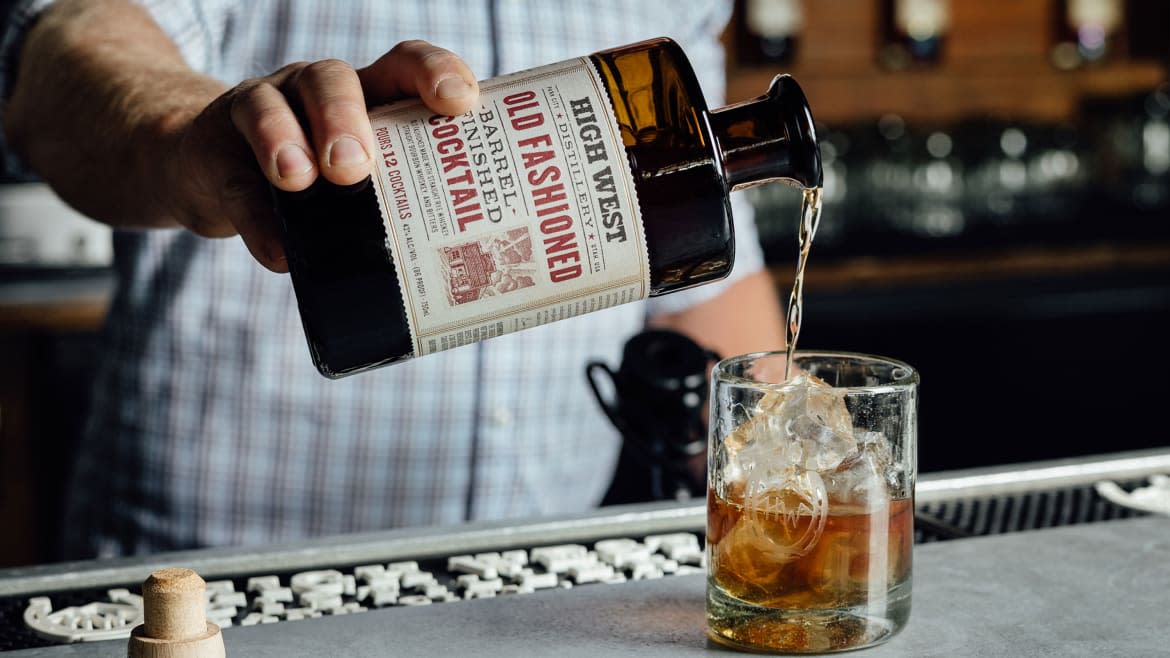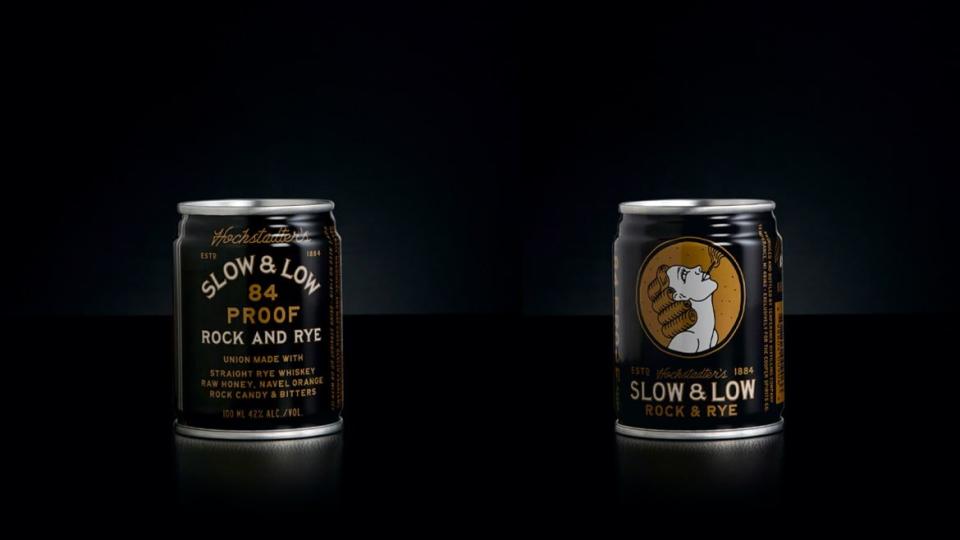Is the Must-Have Gift of 2020 an Old-Fashioned Cocktail?

The Old-Fashioned cocktail is the least likely candidate to find its way into a bottle or can.
It consists of three easy-to-find ingredients—spirits, sugar and bitters—and it takes no specialized equipment or outsized talents to make. Even the moderately competent could be schooled in the basics in under three minutes. It’s often credited as the first drink recipe, with all the fancy ingredients and flourishes being added later.
Building a Whiskey Empire in 85 Years
Is the Old-Fashioned the World’s First Cocktail?
Yet here we are. I have in front of me a half dozen variations of pre-made Old-Fashioneds, including canned, bottled and an Old-Fashioned syrup that requires only the addition of liquor and ice. Quite a few other pre-made variations are out there, and many more are undoubtedly in the pipeline.
I’ve diligently worked my way through these. And in the process I went through two stages. The first was denial—none of them tasted very much like the Old-Fashioneds I make for myself or those made by my favorite bartenders.
But I quickly moved on to the next stage: acceptance. I’ve accepted that these cocktails are not only convenient, but taste like harbingers of winter, and they strike me every bit as seasonal as Hot Toddies and Eggnog. They’re perfect for the Christmas holiday season. Once you notice that they brim with Yuletide flavors, it’s hard to ever not notice that again.
Call them the Yule-Fashioneds. (Or not.)
Across the board, the pre-made drinks I tasted skewed sweet. (This was even true for the spiced syrup when I followed the suggested proportions.) But that’s OK. When you grab a bottled Starbucks coffee drink at a convenience store, you’re not expecting the same coffee flavor that you get from a fresh pull of espresso. The coffee in the bottle is a sweet, coffee-flavored beverage. Much the same could be said of the pre-made Old-Fashioneds.
I’m not sure why the sturdy flavors of an Old-Fashioned fail to translate to the can or bottle. And I’m not the first. “Theoretically, one should be able to make up a lot of this in advance,” wrote British novelist and cocktail aficionado Kingsley Amis about the Old-Fashioned decades ago, “but I have never done so successfully.” Amis doesn’t explain the failure. Perhaps the pre-made Old-Fashioned is like those legendary animals that once caged, lose their will to continue on.
But I’m assuming it’s for a more transactional reason: that the producers are targeting a sophisticated but still broad mass market, which tends to gravitate toward sweet. And it helps if this involves natural sugars rather than high fructose corn syrup. (High West’s Bottled Old-Fashioned touts demerara cane syrup; Hochstadter’s Slow & Low has rock candy and honey.) The result is a cocktail that’s more dense and more sweet—more Mexican Coke, which famously uses cane sugar, than domestic Coke, which uses corn syrup.
Producers also crank up the spice notes beyond a typical Old-Fashioned. Maybe they’re aiming to bring a bigger boombox to the party. Maybe it’s a play to let consumers know it’s worth paying a premium not only for convenience, but for a bold and distinct taste profile.
And these exaggerated spice notes are what make these fit for Christmas—those clarion notes of cinnamon clove and allspice suggest spice cookies baking in the kitchen. Those same spices are the basis of some of the great aromatic bitters, of course. Bitters often linger in the background of a drink, but in these Old-Fashioneds they move front and center. It is the difference between a chorale singing Christmas favorites with five members and one dominating a stage with a hundred.
2020 Is No Match for the Holidays
Meet American Whiskey Pioneer Lance Winters
Hochstadter’s Slow & Low Rock & Rye was the first of the crop of ready-made Old-Fashioneds when released a dozen years ago. Actually, it would be more in the category of Old-Fashioned-ish.
This was the brainchild of Rob Cooper, the spirits entrepreneur who released St-Germain Elderflower Liqueur in 2007. While visiting craft cocktail bars to promote his product, he was struck by the burgeoning interest in rye, a style of whiskey that had long been in eclipse. As it happened, he’d earlier acquired a portfolio of defunct brands, which included the once-popular Hochstadter’s line of spirits, bitters and wine. And within this was a Rock & Rye, which was originally touted as a cure for tuberculosis and involved a mix of botanicals, whiskey and rock candy and dates to around 1884.
Cooper worked with Chad Solomon and Christy Pope, two pioneering craft bartenders, to come up with a recipe to bring it into the modern era. “Rob said, ‘I want to resurrect Rock & Rye but I want to modernize it into a rye Old-Fashioned,’” says Solomon.
Cooper released Slow & Low Rock & Rye ($25 for a 750ml bottle; $5 for 100ml can) at a life-affirming 84 proof, accompanied by the basso profundo notes of honey, spice and dried orange peel.
A touch of orange is, if not essential, always welcome in an Old-Fashioned. (Kingsley Amis noted that “a teaspoon of Grand Marnier, if you have it, upgrades the mixture.”) Recipes often call for muddling an orange peel with sugar for an instant oleo-saccharum. But the difference between orange peel and dried orange peel is the difference between summer and winter. There’s a roasty richness to the dried version that suggests more fireplace than beach.
Slow & Low was released in bottles, but also in cunning 100ml cans, which seem fit for dollhouse. Atlanta-based TipTop Proper Cocktails took the small-can idea and ran with it, rolling out a trio of classic cocktails this year in wee cans designed to look unearthed from the 1940s. The company was launched by two entrepreneurs and childhood friends in their 30s, Neal Cohan and Yoni Reisman. Both were involved in the music festival world, where they embraced the challenge of scaling up classic cocktails for a crowd. In releasing their canned line ($4-$5 each), they sought out flavor profiles that spoke to sophistication rather than a cheap buzz. “It’s really for the consumer who thought this category didn’t have anything to offer them,” says Reisman.

I also sampled a trio of bottled Old-Fashioneds, which included High West ($50), Treaty Oak ($13 for 375ml) and Handy and Schiller’s Barreled Old Fashioned ($40). Helping me was an involuntarily conscripted panel of New Orleans bartenders (Andrea Heming, Alex Utter, Rachel Johnson and Chris Hannah), and we agreed most were rather tasty. I also found these suggestive of the holidays—big and sweet and inducing visions of sugar-plum fairies, largely owing to the outsized notes of clove and allspice.
The crew was especially drawn to the deeply flavored Treaty Oak Old-Fashioned, made with the Texas distillery’s Ghost Hill wheated bourbon and flavored with bitters and notes of orange zest. (Panelist tasting note: “I would drink buckets of it.”)
Both the High West, made in Utah, and the Handy and Schiller, produced by the New Orleans-based Sazerac Co., spend time aging in a barrel, which smoothes the edges and adds depth. Handy and Schiller has dark, toffee-like notes. The High West brings to mind Christmas spice drops, with upfront sweetness edged with prominent orange and back-of-the-throat baking spice notes.
Pratt Standard Cocktail Co., based in Washington, D.C., recently released an Old-Fashioned Syrup ($12 for an 8 oz bottle), which joins its line of other top-notch syrups, including a fiery ginger and a delicate Rosemary Grapefruit. It’s designed to mix with whiskey and ice for a quick cocktail, is sweetened with demerara sugar and highlighted with prominent notes of dried orange and lemon peel.
Old-Fashioned syrups have been cropping up of late—Woodford Reserve Bourbon has one, and there are versions by Proof, WithCo and Strongwater (none of which I’ve yet tried). But the idea isn’t new. Brian Rea, a much venerated bartender in New York in the 1950s, was quoted by Robert Simonson in his 2014 book, The Old-Fashioned, that to meet demand he would make what he called “bug juice,” a mix of simple syrup and Angostura Bitters, in order to speed up orders.
Of all the pre-made Old-Fashioneds, I liked the syrup-made version the best. Pratt Standard brought a dense mouthfeel and wide range of complex flavors to the drink. And I liked that I could adjust the sweetness to taste by adding less and select the whiskey I was in the mood for. I made up two batches for the bartender panel—one with rye and one with bourbon. The rye version was the consensus favorite of the evening, with an aroma vaguely reminiscent of Coca-Cola, and a taste that reminded one bartender of Cinnamon Toast Crunch, but in a good way. The drink was like a quiet Christmas morning, dialed down to about 4, the sort of moment enjoyed with close friends.
And speaking of the holiday spirit—here’s a gift from me to you. Inspired by those who’ve reverse-engineered Pop-Tarts and Thomas’s English Muffins to create from-scratch, at-home versions, I concocted a recipe for a bottled holiday Old-Fashioned. Ramp up the quantity as desired, bottle and then serve individually over ice with an orange peel garnish.
It may not be your preferred year-round Old-Fashioned, but you will appreciate a bottle in the fridge when your holiday pod stops by unexpectedly. I’m thinking this might prove Kingsley Amis wrong.
The Yule-Fashioned
By Wayne Curtis
INGREDIENTS
2 oz Rye whiskey
.5 oz Simple syrup (one part sugar, one part water)
6 dashes Orange bitters
.25 oz St. Elizabeth’s Allspice Dram
Glass: Old-fashioned
Garnish: Orange twist
DIRECTIONS
Add all of the ingredients to an Old-Fashioned glass and fill with a couple ice cubes. Stir, and garnish with an orange twist. Holiday songs optional.
Get our top stories in your inbox every day. Sign up now!
Daily Beast Membership: Beast Inside goes deeper on the stories that matter to you. Learn more.

